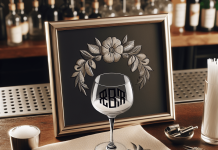Ready to elevate your cocktail game? We’ve always wondered if we could use our fancy wine glasses for sipping on some creative concoctions. So, we embarked on a mission to find out the answer to the age-old question: Can you use wine glasses for cocktails? It turns out, the answer isn’t as simple as a yes or no. Join us as we uncork the truth and explore the art of serving cocktails in wine glasses. Get ready to embrace a new level of sophistication in your home bar!
Choosing the Right Glassware
When it comes to serving cocktails, choosing the right glassware is essential. The glass you use not only affects the presentation of the drink but also enhances the overall drinking experience. In this article, we will explore the different types of cocktail glasses and wine glasses, as well as discuss the considerations, pros, and cons of using wine glasses for cocktails. We will also provide some cocktail recommendations specifically suited for wine glasses, along with tips for using them effectively.
1.1 Types of Cocktail Glasses
Cocktail glasses come in various shapes and sizes, each designed for specific types of drinks. Some popular types of cocktail glasses include:
-
Martini Glass: This iconic glass with its long stem and wide, shallow bowl is perfect for serving classic martinis and other fancy, stirred cocktails. The wide rim allows the aromas to reach the nose, enhancing the drinking experience.
-
Collins Glass: Also known as a highball glass, the Collins glass is tall and narrow, making it ideal for refreshing, carbonated drinks like the Tom Collins or Mojito. Its straight sides and sturdy construction make it easy to hold and also visually appealing.
-
Rocks Glass: The rocks glass, also called an Old Fashioned glass, is short and wide with a thick bottom. It is commonly used for serving cocktails on the rocks or those that are stirred and strained. This glass is perfect for drinks like the Old Fashioned or Negroni.
1.2 Types of Wine Glasses
Just like cocktail glasses, wine glasses come in different shapes and sizes, each designed to enhance the flavors and aromas of specific types of wine. Some common wine glass types include:
-
Red Wine Glass: These glasses have a wide bowl and a larger opening to allow the wine to breathe, enhancing the flavors and aromas. They are designed specifically for red wines like Cabernet Sauvignon and Merlot.
-
White Wine Glass: White wine glasses typically have a smaller bowl and a narrower opening compared to red wine glasses. This design helps to preserve the delicate aromas of white wines like Chardonnay and Sauvignon Blanc.
-
Champagne Flute: The champagne flute is a tall, slim glass with a narrow opening. Its design helps to preserve the carbonation and effervescence of champagne and sparkling wines.
Considerations for Using Wine Glasses for Cocktails
While wine glasses are traditionally used for serving wine, they can also be used for cocktails. However, there are some important considerations to keep in mind when using wine glasses for cocktails.
2.1 Size of the Glass
When selecting a wine glass for a cocktail, consider the size of the glass. Cocktails often require more room for ice, mixers, and garnishes compared to a regular pour of wine. Ensure that the glass has enough capacity to hold the cocktail without overflowing.
2.2 Stem vs Stemless
Another consideration is whether to choose a wine glass with a stem or a stemless design. Stemless wine glasses have become increasingly popular in recent years, as they are less prone to tipping over and are easier to store. However, stemless glasses may not provide the same level of elegance and sophistication as their stemmed counterparts. Consider the aesthetic appeal and practicality when deciding between stem and stemless glasses.
2.3 Bowl Shape and Size
The shape and size of the bowl in a wine glass greatly affect the aromatics and flavors of the drink being served. For cocktails, opt for a wine glass with a bowl shape that complements the specific cocktail you are preparing. Consider whether the cocktail requires room for muddled fruits, ice, or other ingredients and choose the appropriate bowl size accordingly.
2.4 Rim Diameter and Thickness
The rim diameter and thickness of a wine glass can impact the way a cocktail is enjoyed. A thinner rim allows for a smoother sip, while a wider rim can enhance the aroma of the drink. Consider the desired drinking experience when selecting a wine glass for cocktails.
Pros of Using Wine Glasses for Cocktails
Using wine glasses for cocktails has its advantages. Let’s explore some of the pros of using wine glasses for serving cocktails.
3.1 Versatility
One of the main advantages of using wine glasses for cocktails is their versatility. Wine glasses come in various shapes and sizes, making them suitable for a wide range of cocktails. Whether you’re serving a refreshing mojito or a classic martini, chances are there is a wine glass that can accommodate your chosen cocktail.
3.2 Visually Appealing
Wine glasses often have an elegant and sophisticated appearance, adding a touch of elegance to the presentation of cocktails. The long stems and delicate designs of wine glasses can elevate the overall aesthetics of the drink, making it more visually pleasing. This can enhance the drinking experience and make the cocktail feel more special.
3.3 Easier to Handle
The long stems on wine glasses make them easier to handle and hold. This can be particularly beneficial when serving cocktails at social gatherings or events where guests may be mingling. The stems provide a comfortable grip, allowing guests to enjoy their cocktails without worrying about their drink slipping out of their hands.
Cons of Using Wine Glasses for Cocktails
While there are certainly advantages to using wine glasses for cocktails, there are also some potential drawbacks to consider.
4.1 Lack of Proper Aeration
Wine glasses are specifically designed to enhance the aromas and flavors of wine. However, when using wine glasses for cocktails, the lack of proper aeration can affect the overall drinking experience. Some cocktails, especially those with delicate aromatics, may not benefit from being served in a wine glass and may lose some of their intended characteristics.
4.2 Limited Capacity
Wine glasses are typically designed to hold a specific amount of wine, which may not be sufficient for cocktails that require larger quantities of ingredients, such as margaritas or sangrias. The limited capacity of wine glasses can make it challenging to properly mix the ingredients or add garnishes without the drink overflowing.
4.3 Difficulty in Garnishing
Certain cocktails require elaborate garnishes, from citrus twists to fruit skewers. While wine glasses may be visually appealing, they can present a challenge when it comes to garnishing due to their narrow rims. Adding garnishes to a wine glass can be more difficult and may hinder the presentation of the cocktail.
Cocktail Recommendations for Wine Glasses
Despite the potential limitations of using wine glasses for cocktails, there are still many delicious cocktails that can be successfully served in them. Here are a few cocktail recommendations specifically suited for wine glasses:
5.1 Martini
The classic martini is a perfect match for a wine glass. The wide rim and shallow bowl of a wine glass allow the aromas to reach the nose, enhancing the experience of sipping this iconic cocktail. Whether you prefer it shaken or stirred, a martini served in a wine glass exudes elegance and sophistication.
5.2 Mojito
The refreshing flavors of a mojito can be wonderfully complemented by a tall, narrow wine glass. The Collins glass, with its straight sides and sturdy construction, is an excellent choice for serving this minty cocktail. The visual appeal of the mojito in a wine glass adds to the overall enjoyment of the drink.
5.3 Margarita
A margarita served in a wine glass can be a delightful twist on this popular cocktail. The wide bowl of a red wine glass allows for the addition of garnishes like a salted rim or lime wedge, while still showcasing the vibrant colors of the drink. The visual appeal and versatility of a wine glass make it a stylish choice for serving margaritas.
Tips for Using Wine Glasses for Cocktails
To make the most of using wine glasses for cocktails, here are some helpful tips:
6.1 Chill the Glass
Just like with wine, it is important to chill the wine glass before serving a cocktail. This helps to keep the drink at a refreshingly cold temperature for longer and enhances the overall experience. Place the wine glass in the refrigerator or fill it with crushed ice for a few minutes before pouring the cocktail.
6.2 Balance the Ingredients
Consider the proportions of the cocktail ingredients when using a wine glass. The larger bowl size may require adjusting the amounts of each ingredient to achieve a balanced flavor profile. Take the time to experiment and taste-test your cocktail to ensure you have the right ratios for the wine glass you are using.
6.3 Garnish with Style
While garnishing can be more challenging with a wine glass, there are still ways to add that finishing touch to your cocktail. Consider using smaller garnishes like citrus twists or herbs that can easily fit within the narrow rim. Get creative and experiment with different garnishes to enhance the visual appeal of your cocktail.
In conclusion, using wine glasses for cocktails can be a stylish and versatile choice. The wide range of wine glass options allows for creative presentation and adds an extra touch of elegance to your favorite cocktails. However, it is important to consider the specific requirements of the cocktail, the limitations of wine glasses, and apply the appropriate tips to ensure the best drinking experience. So next time you’re hosting a cocktail party or simply enjoying a drink at home, consider reaching for a wine glass and elevate your cocktail experience to new heights. Cheers!








































